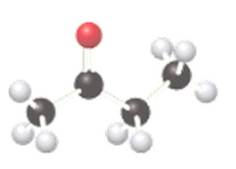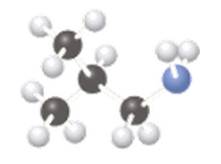
General, Organic, & Biological Chemistry
3rd Edition
ISBN: 9780073511245
Author: Janice Gorzynski Smith Dr.
Publisher: McGraw-Hill Education
expand_more
expand_more
format_list_bulleted
Concept explainers
Question
Chapter 18.3, Problem 18.8P
Interpretation Introduction
(a)
Interpretation:
The compound that has the higher boiling point should be predicted.
 and
and 
Concept Introduction:
The molecular model that is used to represent the 3-D position of the atoms and the bonds between them is known as ball and stick model. In this model, the atom and bond are represented by sphere and rod respectively.
Interpretation Introduction
(b)
Interpretation:
The compound that has the higher boiling point should be predicted.
Concept Introduction:
The molecular model that is used to represent the 3-D position of the atoms and the bonds between them is known as ball and stick model. In this model, the atom and bond are represented by sphere and rod respectively.
Expert Solution & Answer
Want to see the full answer?
Check out a sample textbook solution
Students have asked these similar questions
Please explain how to calculate the pH.
I'm having trouble with converting lewis diagrams into VSEPR diagrams. I currently have this example of C2BrCl3 which I want to turn into a lewis structure, but I'm not sure what steps I need to do in order to do so. I have the table written down, however, there's two central atoms so what would I do? There seems to be 4 electron domains on the carbon atom and no lone pairs so it would seem like this shape would be tetrahedral. Here's what I have now. Thanks!
We discussed the solid phase resin using in peptide synthesis. Provide a mechanism, for its formation. DRAW THE MECHANISM.
Chapter 18 Solutions
General, Organic, & Biological Chemistry
Ch. 18.1 - Prob. 18.1PCh. 18.1 - Prob. 18.2PCh. 18.1 - Prob. 18.3PCh. 18.1 - Prob. 18.4PCh. 18.2 - Prob. 18.5PCh. 18.2 - Prob. 18.6PCh. 18.2 - Prob. 18.7PCh. 18.3 - Prob. 18.8PCh. 18.4 - Decaffeinated coffee is produced by extracting the...Ch. 18.4 - Prob. 18.10P
Ch. 18.5 - Prob. 18.11PCh. 18.5 - Prob. 18.12PCh. 18.5 - Prob. 18.13PCh. 18.6 - Prob. 18.14PCh. 18.6 - Prob. 18.15PCh. 18.6 - Prob. 18.16PCh. 18.6 - Name each ammonium salt. a. ( CH3 NH3)+Cl b. [( CH...Ch. 18.6 - Prob. 18.18PCh. 18.6 - Prob. 18.19PCh. 18.7 - Prob. 18.20PCh. 18.7 - Prob. 18.21PCh. 18.8 - Prob. 18.22PCh. 18.8 - Prob. 18.23PCh. 18.8 - Prob. 18.24PCh. 18.9 - Prob. 18.25PCh. 18.9 - Prob. 18.26PCh. 18.9 - Prob. 18.27PCh. 18.10 - Prob. 18.28PCh. 18 - Prob. 18.29PCh. 18 - Prob. 18.30PCh. 18 - Prob. 18.31PCh. 18 - Prob. 18.32PCh. 18 - Prob. 18.33PCh. 18 - Prob. 18.34PCh. 18 - Prob. 18.35PCh. 18 - Prob. 18.36PCh. 18 - Prob. 18.37PCh. 18 - Prob. 18.38PCh. 18 - Give an acceptable name for each amine. a. b.Ch. 18 - Give an acceptable name for each amine. a. b.Ch. 18 - Give an acceptable name for each amine. a. b. c....Ch. 18 - Give an acceptable name for each amine. a. CH3(...Ch. 18 - Prob. 18.43PCh. 18 - Prob. 18.44PCh. 18 - Prob. 18.45PCh. 18 - Prob. 18.46PCh. 18 - Prob. 18.47PCh. 18 - Prob. 18.48PCh. 18 - Prob. 18.49PCh. 18 - Prob. 18.50PCh. 18 - Which compound in each pair has the higher boiling...Ch. 18 - Which compound in each pair has the higher boiling...Ch. 18 - Draw the hydrogen-bonding interactions that occur...Ch. 18 - Prob. 18.54PCh. 18 - Prob. 18.55PCh. 18 - Which compound has the higher water solubility:...Ch. 18 - Prob. 18.57PCh. 18 - Prob. 18.58PCh. 18 - Draw the products of each acid-base reaction. a....Ch. 18 - Draw the products of each acid-base reaction. a....Ch. 18 - Prob. 18.61PCh. 18 - Prob. 18.62PCh. 18 - What type of nitrogen heterocycle occurs in both...Ch. 18 - Only one of the N atoms in nicotine has a trigonal...Ch. 18 - Prob. 18.65PCh. 18 - Prob. 18.66PCh. 18 - Why are aqueous solutions of an alkaloid slightly...Ch. 18 - Prob. 18.68PCh. 18 - Prob. 18.69PCh. 18 - Explain why patients with Parkinson’s disease...Ch. 18 - Prob. 18.71PCh. 18 - Prob. 18.72PCh. 18 - Prob. 18.73PCh. 18 - Prob. 18.74PCh. 18 - Prob. 18.75PCh. 18 - Prob. 18.76PCh. 18 - Prob. 18.77PCh. 18 - Prob. 18.78PCh. 18 - Prob. 18.79PCh. 18 - Prob. 18.80PCh. 18 - Prob. 18.81PCh. 18 - Prob. 18.82PCh. 18 - Prob. 18.83PCh. 18 - Prob. 18.84PCh. 18 - Prob. 18.85PCh. 18 - Prob. 18.86PCh. 18 - Prob. 18.87PCh. 18 - Why do some antihistamines cause drowsiness while...Ch. 18 - Prob. 18.89PCh. 18 - Prob. 18.90PCh. 18 - Compare the structures of morphine and heroin....Ch. 18 - Prob. 18.92CP
Knowledge Booster
Learn more about
Need a deep-dive on the concept behind this application? Look no further. Learn more about this topic, chemistry and related others by exploring similar questions and additional content below.Similar questions
- (a) 21.8 Name the following compounds. & (b) Br (e) O₂N. (h) H (c) Br (d) NH2 ☑N Br H ہیں Ph (g) OMe бл .0-0.e 21.9 Draw a structural formula for each compound. (a) 2,3-Dinitrotoluene (c) Diphenylmethanol (e) p-Nitroaniline (b) 3-Propylanisole (d) m-Propylphenol (f) Pentabromobenzenearrow_forwardIs this the major product of this reaction?arrow_forwardPlease helparrow_forward
arrow_back_ios
SEE MORE QUESTIONS
arrow_forward_ios
Recommended textbooks for you
 Chemistry for Today: General, Organic, and Bioche...ChemistryISBN:9781305960060Author:Spencer L. Seager, Michael R. Slabaugh, Maren S. HansenPublisher:Cengage Learning
Chemistry for Today: General, Organic, and Bioche...ChemistryISBN:9781305960060Author:Spencer L. Seager, Michael R. Slabaugh, Maren S. HansenPublisher:Cengage Learning Introductory Chemistry: An Active Learning Approa...ChemistryISBN:9781305079250Author:Mark S. Cracolice, Ed PetersPublisher:Cengage Learning
Introductory Chemistry: An Active Learning Approa...ChemistryISBN:9781305079250Author:Mark S. Cracolice, Ed PetersPublisher:Cengage Learning Organic And Biological ChemistryChemistryISBN:9781305081079Author:STOKER, H. Stephen (howard Stephen)Publisher:Cengage Learning,
Organic And Biological ChemistryChemistryISBN:9781305081079Author:STOKER, H. Stephen (howard Stephen)Publisher:Cengage Learning, General, Organic, and Biological ChemistryChemistryISBN:9781285853918Author:H. Stephen StokerPublisher:Cengage Learning
General, Organic, and Biological ChemistryChemistryISBN:9781285853918Author:H. Stephen StokerPublisher:Cengage Learning Chemistry: Principles and PracticeChemistryISBN:9780534420123Author:Daniel L. Reger, Scott R. Goode, David W. Ball, Edward MercerPublisher:Cengage Learning
Chemistry: Principles and PracticeChemistryISBN:9780534420123Author:Daniel L. Reger, Scott R. Goode, David W. Ball, Edward MercerPublisher:Cengage Learning

Chemistry for Today: General, Organic, and Bioche...
Chemistry
ISBN:9781305960060
Author:Spencer L. Seager, Michael R. Slabaugh, Maren S. Hansen
Publisher:Cengage Learning

Introductory Chemistry: An Active Learning Approa...
Chemistry
ISBN:9781305079250
Author:Mark S. Cracolice, Ed Peters
Publisher:Cengage Learning

Organic And Biological Chemistry
Chemistry
ISBN:9781305081079
Author:STOKER, H. Stephen (howard Stephen)
Publisher:Cengage Learning,

General, Organic, and Biological Chemistry
Chemistry
ISBN:9781285853918
Author:H. Stephen Stoker
Publisher:Cengage Learning

Chemistry: Principles and Practice
Chemistry
ISBN:9780534420123
Author:Daniel L. Reger, Scott R. Goode, David W. Ball, Edward Mercer
Publisher:Cengage Learning

Nomenclature: Crash Course Chemistry #44; Author: CrashCourse;https://www.youtube.com/watch?v=U7wavimfNFE;License: Standard YouTube License, CC-BY